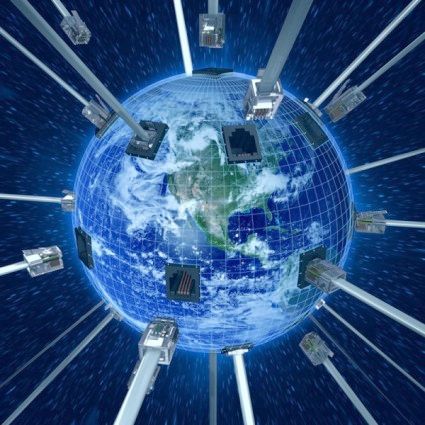The Internet is a global system of interconnected computer networks that use the Internet protocol suite (TCP/IP) to link several billion devices worldwide. It is a network of networks that consists of millions of private, public, academic, business, and government networks of local to global scope, linked by a broad array of electronic, wireless, and optical networking technologies. The Internet carries an extensive range of information resources and services, such as the inter-linked hypertext documents and applications of the World Wide Web (WWW), electronic mail, telephony, and peer-to-peer networks for file sharing.
The origins of the Internet date back to research commissioned by the United States government in the 1960s to build robust, fault-tolerant communication via computer networks. The primary precursor network, the ARPANET, initially served as a backbone for interconnection of regional academic and military networks in the 1980s. The funding of a new U.S. backbone by the National Science Foundation in the 1980s, as well as private funding for other commercial backbones, led to worldwide participation in the development of new networking technologies, and the merger of many networks.
The connection of Australia, Canada, and parts of Asia and Europe to the global TCP/IP system in the late 1980s made the Internet truly global. Prior to about 1988-1989, in order to communicate with computers on other continents one had to use older protocols or dial into the international telephone system.
From approximately 1991 onwards, the introduction of retrieval protocols such as Gopher and the World Wide Web to the public, along with linking of commercial enterprises marked the beginning of the transition to the modern Internet, and generated a sustained exponential growth as generations of institutional, personal, and mobile computers were connected to the network.
Although the Internet has been widely used by academia since the 1980s, the commercialization incorporated its services and technologies into virtually every aspect of modern human life. In 2014, 38 percent of the world's human population had used the services of the Internet within the past year—over 100 times more people than were using it in 1995. Internet use grew rapidly in the West from the mid-1990s to early 2000s and from the late 1990s to present in the developing world.
Most traditional communications media, including telephony and television, are being reshaped or redefined by the Internet, giving birth to new services such as Internet telephony and Internet television. Newspaper, book, and other print publishing are adapting to website technology, or are reshaped into blogging and web feeds. The entertainment industry, including music, film, and gaming, was initially the fastest growing online segment. The Internet has enabled and accelerated new forms of human interactions through instant messaging, Internet forums, and social networking. Online shopping has grown exponentially both for major retailers and small artisans and traders. Business-to-business and financial services on the Internet affect supply chains across entire industries.
The Internet has no centralized governance in either technological implementation or policies for access and usage; each constituent network sets its own policies. Only the overreaching definitions of the two principal name spaces in the Internet, the Internet Protocol address space and the Domain Name System (DNS), are directed by a maintainer organization, the Internet Corporation for Assigned Names and Numbers (ICANN). The technical underpinning and standardization of the core protocols is an activity of the Internet Engineering Task Force (IETF), a non-profit organization of loosely affiliated international participants that anyone may associate with by contributing technical expertise.

